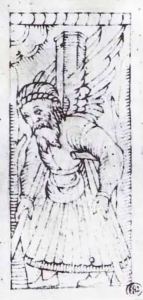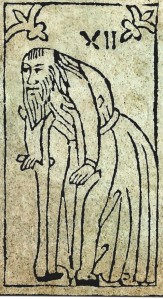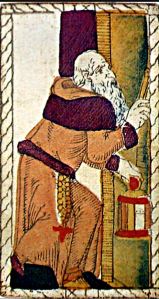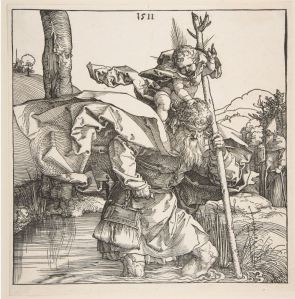L’Eremita/L’Ermite/The Hermit
The Hermit card began as something quite different in fifteenth-century Italy. He was never called the Hermit; and he never carried a lantern. We know from numerous Italian essays, poems and lists of trump cards that the card we call “the Hermit” was named Il Tempo/Time, Il Gobbo/The Hunchback, or Il Vecchio/The Old Man. He carried an hourglass and was the embodiment of Old Man Time (Father Time).
One of the earliest known cards of this type (shown at left) is from a Trionfi deck hand painted for an Italian aristocrat in the middle of the fifteenth century. A well-dressed old man, with a very long gray beard, and wearing a rich blue robe embroidered in gold, stands in front of a rock formation holding up a large hourglass. He is acutely aware that the sands of time are running out for him and embodies three ways Time was pictured in the Renaissance: Petrarch’s allegory of the passage of time; the last age of human life; and the influence of astrological Saturn. Let’s look at how these factors influenced the card’s design.
Time as an old man with an hourglass suddenly appeared in Italian culture in the 1440s. We learned in the Chariot article that Petrarch’s poem I Trionfi set the standard for how artists depicted various allegories like Love, Death and Time. Petrarch didn’t describe the allegory of Time physically, but artists quickly adopted a universal convention for depicting it. The illustration of Petrarch’s poem shown here contains all the elements of the popular allegory. A rather decrepit old man on crutches reminds us of the impact of time on human life. His wings, and the deer pulling his chariot, are symbolic of the swiftness of time. An hourglass with the sands of time running out sits at his feet.
Bologna’s unique card designs originated in the fifteenth century and may show us what the earliest wood block decks looked like. This Bolognese card has all the elements, except for the hourglass, of Petrarch’s Triumph of Time illustrated above. The winged old man on crutches is reminding us that “time flies” and we will become old sooner than we expect. Petrarch said as much in I Trionfi: “considering now the brevity of life, and striving to make ready for the end: This morning I was a child, and now am old.”
“The Ages of Man” was a popular theme in art and literature. As the sands of time run through the hourglass, we pass through several ages of life (four, seven, or ten depending on the source) from infancy, youth, and maturity, to old age. Shakespeare popularized the seven ages in the “All the world’s a stage” speech from As You Like It. We begin life as an “infant mewling and puking” and end with senility, “the second childishness, sans teeth, sans eyes, sans taste, sans everything.” This manuscript illumination depicts the seven ages of life, with Old Age as the bearded man leaning on a cane on the far left. Except for not holding an hourglass, he looks very much like the old man in the trionfi card shown at the top of the page.
Some artists and poets aligned the ages of man with the seven planets. Life begins with infancy under the auspices of the Moon, and ends with old age ruled by Saturn. Astrological Saturn rules unfortunate people: the poor, aged, ill, and disabled, as well as laborers and slaves who do the hardest work for the least reward. This engraving shows people ruled by Saturn: a beggar and a man hobbling on crutches, as well as a farmer laboring in the background. Saturn is also the patron of people with a melancholic temperament: scholars, poets, monks, and anyone whose lifestyle requires solitude—which takes us to the French Tarot de Marseille Hermit discussed below.
The old man on crutches in the Rosenwald deck resembles the man in the Saturn illustration, and seems to be a simplified version of the Rothschild card shown above. The earliest “Hermit” cards are a straightforward illustration of old age and the effects of the passage of time on the human body.
The French Hermit Tarot Card
By the end of the fifteenth century, the old man’s hourglass had been replaced with a lantern, and he lost his association with the passage of time. The lantern appears on all French Hermit cards, but there is an intriguing Italian example. The Budapest cards show the earliest known tarot figure with a lantern. The man has a long beard and a walking stick, but he’s no longer hunched over on crutches. His large hat tells us he’s on the road, perhaps a pilgrim. Is he lighting his path, signaling to someone, or illuminating his face to identify himself to others?
We assume this card is Italian, since the uncut sheets were found mingled with the recycled pages of several Italian books. Perhaps there were other Italian cards with a lantern, now lost, that served as a precedent for French decks. It’s possible the French Hermit is not a dramatic break from Italian cards, but the continuation of a lost Italian tradition.
The earliest French deck we know of was printed by Catelin Geofroy in 1557. Like the Italian figure, he’s a bearded old man. The rosary hanging from his belt tells us he’s probably a monk. He holds a lantern in one hand and with the other seems to be pulling on something, perhaps a bell rope.
Although a few early French cards depict a monk, the card was never given that name. The first decks with titles on the cards, the Tarot de Paris and the Jean Noblet, both printed in Paris in the seventeenth century, are titled LERMITE, The Hermit. That name has been with the card ever since.
Transitional cards, between the fifteenth-century Italian Old Man Time and the seventeenth-century Tarot de Marseille Hermit, have a striking resemblance to depictions of hermits in art. To give one example, there’s Albrecht Durer’s engraving of the giant Reprobus carrying a small boy across a dangerous river. In the background we see a tiny hermit who was Reprobus’ teacher in the Christian faith. As the small boy turned out to be the Christ Child himself, Reprobus was transformed into Saint Christopher, the Christ-Bearer, and the patron saint of travelers.
The Tarot de Marseille Hermit
By 1650, the deck had solidified into the Tarot de Marseille (TdM) pattern. We still have the old man with a gray beard and walking stick from Italian decks, but he’s holding his lantern up high like the Budapest and Geofroy figures. The cloak draped over his arm shielding his lantern is a unique feature of the TdM. The partly obscured light suggests he’s not guiding others, but may be searching for something, like Diogenes searching for an honest man.
This card has remained virtually unchanged up to the present, and served as the prototype for Anglo-American cards.
The Rouen-Bruxelles tarot pattern, a variant of the Tarot de Marseille printed in the 17th and 18th centuries, has several trump cards, including the Hermit, that look back to earlier examples. The Vandenborre Hermit’s knotted rope belt echoes the Catelin Geofroy hermit. He’s holding a rather ambiguous object that doesn’t resemble either a lantern or an hourglass. The way he’s holding it can suggest a book.
The De Hautot Hermit holds neither an hourglass nor a lantern. He resembles the old man in the “Ages of Man” illustration above.
Tarot de Marseille Card Meanings
In the French tarot tradition, the association with Petrarch’s Allegory of Time is lost – except for references to old age. Divinatory meanings are derived from the image of an old man, and from associations with astrological Saturn. The Tarot de Marseille Hermit is a philosopher or spiritual seeker devoted to a quest for wisdom. He turns inward and lives simply and austerely while pursuing solitary studies or spiritual practices.
Divinatory meanings associated with this card include: Silence, celibacy, absence of passion, austerity, solitude, contemplation, and melancholy. It’s also associated with the misery of illness and old age.
The French Occult Hermit
French occultists like Eliphas Levi and Oswald Wirth retained the TdM Hermit image while extending its meaning with their own theories. They associated this card with the Hebrew letter Teth – Roof, which gives safety and protection, like the Hermit’s thick cloak. Then the occultists tell us that the best protection is Prudence.
The tarot deck has three of the four cardinal virtues: Strength, Justice and Temperance. Tarot scholars have been on the hunt for the fourth virtue, Prudence, for centuries. Several cards have been put forward as the missing virtue. An example is the Charles VI deck where the virtue Prudence is represented by the World card. However, French occultists were certain the Hermit is the fourth virtue.
Prudence is defined as the ability to distinguish good versus bad. It’s the ability to learn from the past, make wise choices in the present, and plan intelligently for the future. The Hermit’s lantern is the light of the mind that illuminates past, present and future. This ability to encompass three phases of time refers back to the Allegory of Time.
Oswald Wirth adjusted the design of his Hermit card to associate it with Prudence. The traditional figure of Prudence holds a mirror and a snake. The mirror is for seeing behind herself into the past, and the snake may refer to a quote from the Bible, Matthew 10:16: Be ye wise as serpents.
Instead of a crutch or walking stick, Wirth’s Hermit wields a bamboo cane with seven symbolic knots. His cloak creates a closed alchemical vessel where inner work can take place. This Hermit is austere, withdrawn and detached from life. He doesn’t teach students, preferring to mediate on great truths in silence.
The Golden Dawn Tarot
When the Hermit travelled across the English Channel to join the Hermetic Order of the Golden Dawn, he came out from under his cloak to share his light with the world.
The Golden Dawn’s hermit stands on a high plateau under the stars, lantern held out with its light visible for all to see. The Order calls him the Magus of the Voice of Light, and the Light Bearer who brings messages from higher dimensions. Thanks to his solitary search for wisdom, and his spiritual practices, he is open to receiving divine wisdom from higher sources. The time for withdrawal and solitude is over. He is ready to share his light with the world. He may be old, but the passing of time means he has acquired wisdom, not that he’s become decrepit.
The Waite Smith Tarot
In his book The Pictorial Key to the Tarot, A. E. Waite disagrees with everything the French occultists said about this card. According to Waite, the Hermit doesn’t need to protect himself, or his lantern, with his cloak. This card is not about self-protection, isolation, or withholding yourself from the world and protecting your precious occult knowledge from contamination. Nor is he on a quest for wisdom. He has already completed his quest and has reached the heights, thus becoming a way-shower, the wise guide who will lead students to the light. By holding his lantern up as a beacon for others to see, he assures us we can reach the same heights that he has reached.
Waite innovated by putting the Hermit on a mountain top for maximum visibility. The lantern’s light is a six-pointed star made of two interlaced triangles – an alchemical symbol for spiritual energies descending into the material world, and the material world aspiring to spiritual heights. His lantern’s light is a guiding star.
Modern interpretations of this card are inspired by Waite, with a psychological twist. This Hermit advises you to pull back from over-involvement in social media and non-essential activities, clear your schedule, and spend time in solitude reflecting on your life and doing any emotional healing that’s necessary. The contemporary Hermit is more than a philosopher or religious seeker. He can be a therapist, guru. teacher, or spirit guide who accompanies you on your quest for wisdom and personal integration. He has gone down the path ahead of you and lights your way, as well as shining a light into the dark places of your soul that need compassion and healing. On the other hand, this card may be challenging you to embody the Hermit. Have you acquired the life experience and wisdom needed to serve as a guide and mentor to others? The Hermit’s path may ultimately lead out of solitude and introspection and back into the world where you hold your light up to inspire others.
Contemporary Hermit Cards



The bag lady takes us back to the first Italian cards—children of Saturn—society’s poor and unfortunate. Protected by bulky, shapeless clothing, she’s easily overlooked. But like many solitary people, she has a rich inner life. As an outsider and an observer of life, the bag lady sees more, and understands more, than most people. She carries her life experience in her shopping bags, and could share her wisdom, if only people would take the time to listen.
The solitary contemplative has withdrawn to a quiet oasis and gazes at her reflection in a moonlit pool. She’s taking a time-out from over-involvement in life to get in touch with her authentic self. Perhaps she’s processing a recent trauma, or integrating insights that have come to her in dreams or meditation. Like the Tarot de Marseille Hermit, her focus is inward toward self-understanding and personal growth.
The alchemical Hermit is taken from an illustration in the emblem book Atalanta Fugiens by Michael Maier. The original engraving shows an elderly, bearded seeker with a walking stick and lantern eagerly following the footprints left by the anima mundi. He’s an alchemist and scientist on a solitary quest for knowledge of the spiritual principles that underly material reality.
Conclusion
The Hermit card has gone through subtle transformations over the centuries, but certain core attributes remain. He’s old, solitary, dressed plainly, and walks outdoors holding up a symbolic hourglass or lantern. Depending on where we are in life, we may look up to the Hermit as a guide, or we may be ready to play that role ourselves. But some Hermits just want to be left alone to pursue their wisdom quest in solitude. What is the true nature of the Hermit in your deck?
See more cards and art at https://www.tarotwheel.net/history/the%20individual%20trump%20cards/el%20gobbo.html
Next Page – The Wheel of Fortune
Illustrations:
Charles VI Tarocchi, mid 15th century, Florence/Ferrara. Restored by Marco Benedetti, 2020.
Petrarch’s Triumph of Time. Woodblock print in a book published by Genua and Strizzi, 1499, Rome, Italy.
Rothschild Sheet, c. 1500. Collection of Bibliothèque de l’Ecole Nationale Supérieure des Beaux-Arts, Paris.
Seven Ages of Man from “On the Property of Things”. Bartholmaeus Anglicus, 1482. Illuminated manuscript. Collection of the British Library.
Saturn and its Children. Harmen Jansz Muller. c. 1566.
Rosenwald Tarocchi, c. 1500. Florentine milieu. Restored by Sullivan Hismans.
Budapest Tarocchi, late 15th century. Collection of the Museum of Fine Arts, Budapest and the Metropolitan Museum of Art, New York City.
Catelin Geofroy Tarot, c. 1557. Collection of Museum fur Kuntzhandwerk, Offenbach, Germany. Accessed at cards.old.no
Saint Christopher (detail). Albrecht Durer, 1511. Collection of the Metropolitan Museum, New York.
Nicolas Rolichon Tarot de Marseille. Lyon, late 17th century. Restored by Marco Benedetti, 2019.
Diogenes Searching for an Honest Man. Attributed to J. H. W. Tischbein, c. 1780.
Tarot Flamand Vandenborre. Brussels, 1762. Restored by Pablo Robledo, Argentina, 2018.
Adam C. De Hautot Tarot, 18th century. Restored by Sullivan Hismans, Tarot Sheet Revival, 2018.
Oswald Wirth Tarot, 1887. Collection of the Bibliothèque Nationale Française, Paris.
The Golden Dawn Tarot. Robert Wang and Israel Regardie. U.S. Games, Systems Inc., Stamford, CT, 1977.
The Centennial Waite Smith Tarot Deck. London, 1909. U.S. Games System, Inc., Stamford, CT, 2009.
Tarot of the Crone. Ellen Lorenzi-Prince. Arnell’s Art, 2017
Songs for the Journey Home. Katherine Cook and Dwariko Von Summaruga. Self-Published, 1996, 2006.
The Alchemical Tarot. Robert Place. Thorsons, 1995.


















Time & light can be combined in “The light of experience”
The Hermit’s lamp doth brightly shine
With light of wisdom, borne of time
To show the way within that’s true
It shines for me, it shines for you.
Very nice how you combined time and light.